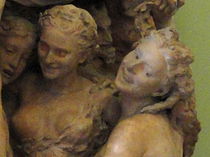Jean-Baptiste Carpeaux
Jean-Baptiste Carpeaux | |
|---|---|
 Illustration of Carpeaux by Étienne Bocourt in the Illustrated Sporting and Dramatic News, after his death. His Flore is below him, and other work above | |
| Born | 11 May 1827 |
| Died | 12 October 1875 (aged 48) |
| Nationality | French |
| Known for | Sculpture, painting |
Jean-Baptiste Carpeaux (11 May 1827 – 12 October 1875) was a French sculptor and painter during the Second Empire under Napoleon III
Life[edit]
Born in Valenciennes, Nord, son of a mason, his early studies were under François Rude. Carpeaux entered the École des Beaux-Arts in 1844 and won the Prix de Rome in 1854, and moving to Rome to find inspiration, he there studied the works of Michelangelo, Donatello and Verrocchio. Staying in Rome from 1854 to 1861, he obtained a taste for movement and spontaneity, which he joined with the great principles of baroque art. Carpeaux sought real life subjects in the streets and broke with the classical tradition.
While a student in Rome, Carpeaux submitted a plaster version of Pêcheur napolitain à la coquille, the Neapolitan Fisherboy, to the French Academy. He carved the marble version several years later, showing it in the Salon exhibition of 1863. It was purchased for Napoleon III's empress, Eugénie. The statue of the young smiling boy was very popular, and Carpeaux created a number of reproductions and variations in marble and bronze. There is a copy, for instance, in the Samuel H. Kress Collection in the National Gallery of Art in Washington, D.C.. Some years later, he carved the Girl with a Shell, a very similar study.
In 1861, he made a bust of Princess Mathilde, and this later brought him several commissions from Napoleon III. Then in 1866, he established his own atelier in order to reproduce and make work on a grander scale. In 1866, he was awarded the chevalier of the Legion of Honour.[1]
He employed his brother as the sales manager and made a calculated effort to produce work that would appeal to a larger audience.[2] On 12 October 1875, he died at the Chateau de Bécon.[1]
Among his students were Jules Dalou, Jean-Louis Forain and the American sculptor Olin Levi Warner. Carpeaux died at age 48 in Courbevoie.
Work[edit]
- Ugolin et ses fils (Ugolino and his sons) (1861; Metropolitan Museum of Art)[3] with versions in other museums including the Musée d'Orsay, Paris.
- The Dance, commissioned for the Opera Garnier in 1869, featuring several nude figures in a wild and boisterous dance, criticized as an offense to common decency
- fr (Neapolitan Fisherboy) (Musée du Louvre, Paris)[4]
- Young girl with a shell, Valenciennes
- Antoine Watteau monument, Valenciennes
- Flora and bas-reliefs for the southern facade of the Pavillon de Flore, Palais du Louvre, for architect Hector Lefuel, 1865
- The multifigure allegorical group on the top of the City Hall of his home town, Valenciennes, 1860–1873
- Fontaine de l'Observatoire, also known as the Carpeaux Fountain, south of the Jardin du Luxembourg. Partly complete at his death, Carpeaux finished the terrestrial globe with the cardinal points represented by the four figures of Asia (East), Europe (North), America (West) and Africa (South).[5]
- L'Amour à la folie, part of a group "La danse" for the facade of the Opera Garnier (1869)
Images[edit]
-
Bust of Carpeaux Saint Roch Cemetery
-
The Seasons turning the celestial Sphere for the Fountain of the Observatory, Jardin du Luxembourg
-
Patinated plaster model for Valenciennes defending the arts of peace with the arts of war
-
La Danse (The Dance), for the Opera Garnier, heavily criticized as being indecent
-
Ugolino and his sons, 1857–60. Photographed at the Metropolitan Museum of Art
-
Le Triomphe de Flore (The Triumph of Flora). South façade of the Pavillon de Flore, Louvre Palace, Paris
References[edit]
 | |
- ^ a b
 Chisholm, Hugh, ed. (1911). . Encyclopædia Britannica (11th ed.). Cambridge University Press.
Chisholm, Hugh, ed. (1911). . Encyclopædia Britannica (11th ed.). Cambridge University Press. {{cite encyclopedia}}: Cite has empty unknown parameters:|HIDE_PARAMETER15=,|HIDE_PARAMETER13=,|HIDE_PARAMETER14c=,|HIDE_PARAMETER14ab=,|HIDE_PARAMETER3=,|HIDE_PARAMETER1=,|HIDE_PARAMETER4=,|HIDE_PARAMETER2=,|HIDE_PARAMETER8=,|HIDE_PARAMETER14bb=,|HIDE_PARAMETER20=,|HIDE_PARAMETER5=,|separator=,|HIDE_PARAMETER14b=,|HIDE_PARAMETER14cb=,|HIDE_PARAMETER14a=,|HIDE_PARAMETER10=,|HIDE_PARAMETER9=,|HIDE_PARAMETER6=,|HIDE_PARAMETER7=,|HIDE_PARAMETER11=, and|HIDE_PARAMETER12=(help) - ^ Frusco, Peter, Janson, H.W., The Romantics to Rodin, George Braziller, Inc., 1980
- ^ Script error: No such module "Vorlage:Internetquelle". Abgerufen am 4. Oktober 2014.
- ^ Script error: No such module "Vorlage:Internetquelle". Abgerufen am 4. Oktober 2014.
- ^ See the article by Elizabeth McGrath in The Slave in European Art: From Renaissance Trophy to Abolitionist Emblem, ed Elizabeth Mcgrath and Jean Michel Massing, London (The Warburg Institute) 2012
- ^ Script error: No such module "Vorlage:Internetquelle". Abgerufen am 4. Oktober 2014.
- ^ Script error: No such module "Vorlage:Internetquelle". Smarthistory at Khan Academy, abgerufen am 23. Februar 2013.
External links[edit]
- A page from insecula.com listing more views of Carpeaux's works (it may be necessary to close an advertising window to view this page)
- A page analysing Carpeaux's Ugolino, with numerous illustrations
- Europe in the age of enlightenment and revolution, a catalog from The Metropolitan Museum of Art Libraries (fully available online as PDF), which contains material on Carpeaux (see index)
- Pages with script errors
- CS1 errors: empty unknown parameters
- Wikipedia articles incorporating a citation from the 1911 Encyclopaedia Britannica with Wikisource reference
- Articles without Wikidata item
- Articles with hCards
- Commons category link is the pagename
- Articles with VIAF identifiers
- Pages with red-linked authority control categories
- Articles with WorldCat-VIAF identifiers
- Articles with LCCN identifiers
- Pages using authority control with parameters
- 1827 births
- 1875 deaths
- People from Valenciennes
- French architectural sculptors
- Prix de Rome for sculpture
- Academic art
- 19th-century French painters
- 19th-century French sculptors






